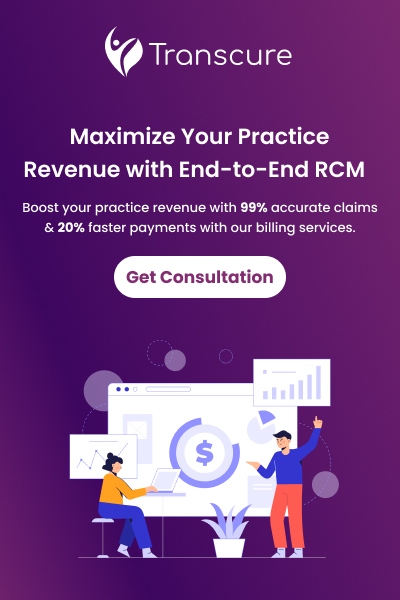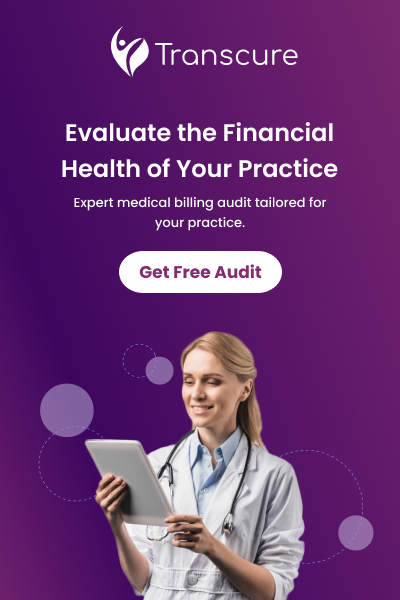Table of Contents
Toggle- Overview
- How Predictive Analytics Is Transforming Healthcare?
- Understanding Predictive Analytics in Healthcare
- Using Predictive Analytics to Improve Clinical Care
- Leveraging Predictive Analytics for Revenue Cycle Management
- Predictive Analytics Reducing Claim Denials and Optimizing Reimbursement
- Implementing Predictive Analytics to Cut Costs and Boost Profits
- Challenges of Adopting Predictive Analytics in Healthcare
- Best Practices for Healthcare Predictive Analytics Success
- Conclusion
- FAQ: Answering Common Questions About Predictive Analytics in Healthcare
Overview
You’ve probably heard about how predictive analytics revolutionizes the retail, insurance, and banking industries. But did you know it’s also transforming healthcare? It uses algorithms and machine learning to analyze huge amounts of data and detect patterns to predict future outcomes. For healthcare systems and hospitals, this means being able to anticipate patient needs, reduce readmissions, improve care, and, yes, even generate more revenue. As healthcare costs continue to rise, optimizing the revenue cycle is crucial. Predictive analytics in healthcare is helping organizations achieve this by enabling more accurate medical billing and coding, reducing claim denials, and improving collections. Predictive analytics should be on your radar if you run a healthcare organization. It’s the future of data-driven healthcare and could significantly impact your bottom line.
How Predictive Analytics Is Transforming Healthcare?
Predictive analytics is revolutionizing healthcare revenue cycle management. Healthcare organizations can gain valuable insights to optimize financial performance by leveraging data and algorithms.
- Accurate Reimbursement Forecasting
Predictive models analyze historical claims data to anticipate reimbursements for specific procedures. This helps determine appropriate fees to charge upfront and ensures maximum reimbursement. By predicting reimbursement rates for standard procedures, you’ll have a data-driven approach to setting fees.
- Reduced Claim Denials
It pinpoints claims likely to be denied before they’re submitted based on patterns in past denials. Staff can then address issues proactively, avoiding rework. Some systems even suggest how to remedy the claim to increase the chance of approval. Predicting and preventing avoidable denials improves revenue collection and reduces wasted effort.
- Optimized Staffing Levels
Predictive analytics assess how workflow variables like seasonality, staffing levels, and patient volume impact metrics such as days in A/R. Using this insight, you can adjust staffing to maximize productivity and revenue. For example, increasing billing staff in high-volume periods or reassigning staff to focus on denial management during peak times.
- Personalized Patient Engagement
Predictive analytics leverage patient data to anticipate individuals likely to pay medical bills. Outreach campaigns can then target these patients to improve self-pay collections. An empathetic, personalized approach is more effective than a one-size-fits-all strategy. It enables a tailored patient financial experience. It transforms healthcare revenue cycle management by leveraging data in new ways. The results are improved reimbursement, reduced costs, increased cash flow, and an enhanced patient financial experience. Isn’t it time your organization started benefitting from predictive analytics?
Understanding Predictive Analytics in Healthcare
Predictive analytics allows healthcare organizations to analyze huge amounts of data to identify patterns and make predictions. For revenue cycle management, this means uncovering insights that can optimize everything from scheduling to billing and collections.
By leveraging historical data and machine learning algorithms, predictive analytics tools can anticipate patient no-shows, procedure durations, staffing needs, and payment likelihood.
- Forecasting Patient Behavior
With access to information like past appointments, diagnoses, and billing, the software learns patients’ patterns and can calculate the odds of them missing an appointment or defaulting on payment. Staff can then take action like reminder calls, double booking slots, or arranging payment plans.
- Optimizing Resource Allocation
Analyzing past procedure times, staff schedules, and workload allows the system to predict ideal staffing levels and slot durations. It may reveal that a specific doctor habitually runs behind schedule on Mondays or that more nursing support is needed for a particular treatment. Administrators can use these insights to minimize wait times, reduce overtime, and effectively allocate resources.
- Improving Billing and Collections
Predictive analytics can determine the likelihood of claims being paid in full and on time by evaluating factors like insurance type, medical codes, patient location, and payment history. The staff knows which claims need follow-up or appeal to avoid write-offs and maximize reimbursement. They can also identify patients at high risk of defaulting so they can arrange affordable payment plans to recover more of the total billings.
With predictive analytics transforming healthcare revenue cycle management, organizations gain data-driven insights that allow them to operate more strategically and efficiently. The benefits of improved resource utilization, reduced costs, and optimized billing and collections are significant. While an initial investment is required, the potential long-term gains make a compelling case for implementation.
Using Predictive Analytics to Improve Clinical Care
Predictive analytics is helping healthcare organizations improve clinical care in exciting new ways. By analyzing huge amounts of data, predictive models can identify at-risk patients, predict health events, and enable preventive action.
- Identifying High-Risk Patients
Healthcare providers can analyze data from electronic health records, insurance claims, and other sources to pinpoint patients at high risk of health events like hospital readmissions, complications, or chronic disease flare-ups. For example, a model may detect patterns that show a patient with congestive heart failure has a high chance of being readmitted within 30 days after discharge based on factors like their medical history, current symptoms, and lifestyle. The care team can then take extra precautions to manage the patient’s care and avoid a return trip to the hospital.
- Anticipating and Preventing Health Events
Predictive analytics excels at detecting early signs that a health event may be imminent. Models can monitor data streams in real-time to identify these warning signs and alert care providers to take preventive action. For instance, a model could detect subtle changes indicating a patient’s chronic condition worsens before obvious symptoms appear. Doctors may then adjust treatment plans or schedule follow-up visits to help get the condition back under control.
Some healthcare organizations use predictive models to generate personalized patient health risk scores. The scores summarize a patient’s likelihood of various health events so doctors can take a more proactive, tailored approach to their care. Patients also benefit by gaining insights into their health risks and the steps they can take to lead healthier lives.
- Optimizing Resource Utilization
By gaining advanced notice of potential health events, care teams have more time to coordinate treatment plans and schedule staff and resources accordingly. They can ensure patients get the right level of care at the right time while avoiding unnecessary emergency room visits or hospital admissions when possible. This helps control costs, reduces waste, and creates an overall more efficient system.
In the end, predictive analytics may transform healthcare from a reactive model to a proactive model focused on prevention and wellness. By leveraging data and technology, predictive analytics can help physicians save lives, improve patient outcomes, and build a sustainable healthcare delivery system for the future.
Leveraging Predictive Analytics for Revenue Cycle Management
Predictive analytics allows healthcare organizations to leverage data to understand revenue cycle performance better and take targeted actions to improve it. Predictive models can anticipate future events and outcomes by uncovering trends and patterns in historical data. This insight enables more proactive management of the revenue cycle.
- Identifying At-Risk Accounts
Predictive models analyze accounts receivable data to detect patterns that indicate a higher likelihood of delayed or missed payments. Accounts that match these patterns can be flagged as “at risk” so staff can prioritize them for targeted follow-up. This helps prevent accounts from deteriorating and maximizes the chance of prompt payment.
- Optimizing Staff Performance
Predictive analytics can also evaluate revenue cycle staff performance to determine factors linked to higher productivity and effectiveness. Leadership can then refine training, adjust workloads and schedules, and implement incentives to increase performance across the board. This optimization of human resources is vital to an efficient revenue cycle.
- Forecasting Cash Flows
Predictive models can estimate future cash inflows and outflows by analyzing historical billing, payment, and collections data. This cash flow forecasting allows administrators to manage resources better and make key business decisions. If a revenue shortfall is predicted, action can be taken to avoid disruption.
- Reducing Costs
When trends like seasonal changes in the volume of claims or payments are detected, schedules and staffing levels can be adjusted accordingly to avoid excess costs during temporary lulls. It may also reveal inefficiencies in workflow and processes that can be remedied to cut costs in the long run. Savings from reduced labor-denied claims and bad debt can be significant.
In summary, predictive analytics gives healthcare organizations the power of foresight for smarter revenue cycle management. With data-driven insights into accounts, staff, cash flows, costs, and more, leaders can transform a reactive revenue cycle into a proactive one and see the benefits to the bottom line.
Predictive Analytics Reducing Claim Denials and Optimizing Reimbursement
Predictive analytics can significantly reduce denied claims and ensure maximum reimbursement for the care you provide. By analyzing historical claims data, predictive models can identify patterns indicating a higher likelihood of denial before a claim is submitted.
- Identify High-Risk Claims
Predictive models scan your historical claims data to pinpoint characteristics of claims denied, like missing procedure codes, insufficient medical necessity documentation, or clerical errors. The models can then flag new claims with similar attributes as “high-risk,” so staff can review and resolve potential issues before submitting the claim. This proactive approach can help avoid unnecessary denials that damage revenue and patient satisfaction.
- Optimize Billing Procedures
Predictive analytics may also reveal opportunities to improve internal billing procedures to minimize errors and maximize reimbursement. For example, if the models detect specific diagnosis or procedure codes frequently billed incorrectly or omitted, you can implement enhanced validation for those codes. Or if time-of-service denials are common, you may need to retrain staff on proper billing procedures. Continuous monitoring of predictive models allows revenue cycle teams to make targeted Improvements that move the needle.
- Negotiate Better Contracts
The insights from predictive analytics can also help during payer contract negotiations. If the models show certain payers are more prone to denying certain types of claims, you have data to back up requests for higher reimbursement rates for those services. Payers may be willing to negotiate if you demonstrate a track record of proper billing and medical necessity. Knowledge is power, and predictive analytics arms you with the knowledge you need to get the best deals.
By leveraging the power of predictive analytics, healthcare organizations can gain valuable foresight into potential revenue cycle pitfalls and opportunities. Reducing denials, optimizing billing procedures, and negotiating stronger payer contracts are just a few ways predictive analytics transforms the healthcare revenue cycle. The future of maximizing reimbursement and financial performance is here.
Implementing Predictive Analytics to Cut Costs and Boost Profits
Predictive analytics is revolutionizing healthcare revenue cycles by identifying cost-cutting and profit-boosting opportunities. As a healthcare organization, you likely have access to a wealth of data that can be leveraged to optimize your revenue cycle management. By implementing predictive analytics, you can uncover insights to reduce denied claims, improve coding accuracy, and streamline workflows.
- Reduce Denied Claims
Around 30% of healthcare claims are denied initially, costing the industry over $262 billion annually. Predictive analytics can help identify claims at high risk of denial before they’re submitted. By reviewing historical claims data, you can determine patterns in denials and build models to predict future denials. Claims flagged as high-risk can then be reviewed and corrected before submission, reducing your denial rate and saving time and money.
- Improve Coding Accuracy
Inaccurate coding is another major revenue cycle issue, with some estimates putting the cost at $125,000 per physician annually. Predictive coding uses natural language processing to analyze historical charts and codes to identify patterns. The models can then review new charts and codes, flagging any that don’t match expected patterns. Coders can review these flags to determine if any changes need to be made before claims submission. This helps minimize coding errors and maximizes reimbursement.
- Streamline Workflows
It can also help optimize revenue cycle workflows by identifying bottlenecks and inefficiencies. You can pinpoint areas where more time and resources are spent by analyzing metrics like days in accounts receivable (AR) and rework rates. Predictive models can then suggest process changes to implement that will speed up workflows, decrease AR, and lower costs. Continually measuring the impact of changes with predictive analytics creates a cycle of continuous improvement.
Leveraging the data and technology at your disposal is key to overcoming the challenges facing healthcare revenue cycles today. Implementing predictive analytics solutions is an investment that can pay off through denied claim prevention, coding accuracy, and workflow streamlining. The insights gained can help transform your revenue cycle management, cutting costs and boosting your bottom line.
Challenges of Adopting Predictive Analytics in Healthcare
Adopting predictive analytics in healthcare can be challenging. Many healthcare organizations are still adjusting to using data in new ways.
- Resistance to Change
Switching from reactive to proactive processes can be difficult for some. Doctors and staff may be hesitant to embrace predictive insights if they’re used to operating based on experience alone. Educating teams on the benefits of predictive analytics and Implementing changes gradually can help overcome this resistance.
- Data Quality Issues
Poor data quality is one of the biggest obstacles. Predictions are only reliable if data is accurate, complete, and consistent. Healthcare organizations must invest in Improving data governance and management before implementing predictive analytics.
- Lack of Analytics Expertise
Many healthcare systems need dedicated data scientists and analysts on staff. They may need help with building predictive models and interpreting the results. Partnering with analytics vendors or consultants is often the best approach until internal teams can develop the needed skills.
- Concerns About Bias
Some worry that predictive analytics may discriminate unfairly against certain groups. Models should be carefully designed and monitored to avoid biases related to gender, ethnicity, or socioeconomic status. Using diverse data and validating models for fairness can address these concerns.
- High Costs
While predictive analytics can save money in the long run, initial investments in technology, data, and talent can be expensive. For smaller healthcare organizations, costs may seem prohibitive. Looking for ways to start small by focusing on high-impact use cases can make adoption more financially feasible.
With the right mindset, good data, analytical skills, and an incremental approach, healthcare systems can overcome challenges and reap the rewards of predictive analytics. It is transforming healthcare revenue cycles, and the future is now!
Best Practices for Healthcare Predictive Analytics Success
Remember these best practices to get the most out of healthcare predictive analytics.
- Invest in High-Quality Data
The key to good predictions is good data. Ensure you have robust, high-quality data from your organization, including clinical, financial, and operational data. Look for gaps and inconsistencies in the data and work to resolve them. Clean, integrated data will lead to much more accurate predictions.
- Choose Relevant Metrics
Focus your predictive models on the metrics for your organization, like patient retention, risk of readmission, likelihood to pay medical bills or patient satisfaction. The more targeted your metrics, the more valuable your insights will be.
- Continuously Test and Refine
Start with a pilot program to test the effectiveness of your predictive models before rolling them out broadly. Get user feedback and look for ways to make the models more accurate and impactful. Make refinements as needed and continue testing new data and algorithms to improve predictions over time.
- Educate and Train Staff
For predictive analytics to truly transform your revenue cycle, staff across the organization must understand its value and how to use the insights. Educate staff on how the models work and provide ongoing opportunities for training to help people get comfortable with the data and confident in acting on predictions.
- Review and Revise Processes
Use the predictions from your models to find opportunities to improve key processes, especially in patient access, billing, and collections. Look for ways to reduce errors, increase efficiency, and optimize resource allocation based on patient needs and risks. Continuously updating processes will maximize the benefits of your investments.
Following these best practices will set your healthcare organization up for success with predictive analytics. With high-quality data, targeted metrics, and continuous testing. education, and process improvements, you’ll gain valuable insights to enhance revenue cycle performance.
Conclusion
So what does all this mean for you? Predictive analytics in healthcare is changing the game. As hospitals and healthcare systems adopt predictive tools and technologies, revenue cycles are getting smarter, faster, and more efficient. Billing and collections processes that used to take weeks or months now happen in days. Insurance claims that would have been denied are now approved, thanks to more accurate coding and documentation. Patients get faster access to the care they need.
FAQ: Answering Common Questions About Predictive Analytics in Healthcare
How does predictive analytics work?
Predictive analytics uses historical data to identify patterns and predict future outcomes. In healthcare revenue cycle management, predictive analytics examines patient demographics, insurance coverage, procedures, diagnoses, and past billing to forecast denial rates, bad debt, and payment rates. This helps streamline operations and maximize revenue.
What are the main benefits of predictive analytics for healthcare revenue cycle management?
- Reduced denial rates: Predictive analytics can help determine which claims are most likely to be denied based on historical data, allowing staff to address potential issues before claims are submitted.
- Improved coding accuracy: Analytics may point to frequently used codes that often lead to denials or underpayments, allowing for additional coder education.
- Decreased bad debt: Predictive models can help determine which patients are most likely to pay and which may become bad debt so that staff can focus collection efforts appropriately.
- Optimized staffing: It may reveal high volume or complexity periods so leadership can ensure adequate staffing. This helps maximize productivity and revenue.
- Increased cash flow: Healthcare facilities often see a sizable increase in cash flow and revenue with fewer denials, reduced bad debt, and optimized operations.
How long does it take to implement predictive analytics? How much does it cost?
The timeline and cost to implement predictive analytics for healthcare revenue cycle management vary significantly based on the existing technology infrastructure and data availability. Many options are available, from basic tools that take weeks to deploy to enterprise-level systems that may take 6-12 months to implement fully. Costs range from a few thousand to several hundred thousand dollars per year. However, the potential return on investment is substantial, often providing a complete ROI within the first year.











